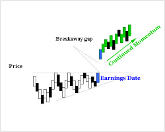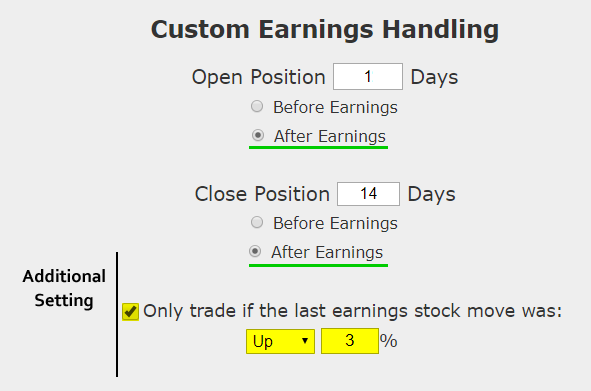Pattern Identification: How to Trade Apple

Apple (NASDAQ:AAPL) : Pattern Recognition
DisclaimerThe results here are provided for general informational purposes, as a convenience to the readers. The materials are not a substitute for obtaining professional advice from a qualified person, firm or corporation.
LEDE
Pattern recognition is critical to option trading. One of the many patterns we scan for is best seen in Apple. Here's what it looks like, at a glance:

THE PATTERN
If you've ever seen a stop rip off of earnings and wondered if that was a signal for a trade, or if the momentum would continue, then this is exactly the back-test you are after. We call it "star gazing" when a stock rips and we're stuck -- with no idea what to expect next.In Apple, if the stock move immediately following an earnings result was large (3% or more to the upside), if we test waiting one-day after that earnings announcement and then bought a three-week at the money (50 delta) call, the results were quite strong.
We can test this approach without bias with a custom option back-test. Here is the timing set-up around earnings:

Rules
* Condition: Wait for the one-day stock move off of earnings, and if it shows a 3% gain or more in the underlying, then, follow these rules:
* Open the long at-the-money call one-trading day after earnings.
* Close the long call 14 calendar days after earnings.
* Use the options closest to 21 days from expiration (but more than 14 days).
This is a straight down the middle direction trade -- this trade wins if the stock is continues on an upward trajectory after a large earnings move the two-weeks following earnings and it will stand to lose if the stock does not rise. This is not a silver bullet -- it's a trade that needs to be carefully examined.
But, this is a conditional back-test, which is to say, it only triggers if an event before it occurs.
RISK CONTROL
Since blindly owning calls can be a quick way to lose in the option market, we will apply a tight risk control to this analysis as well. We will add a 40% stop loss and a 40% limit gain.

In English, at the close of every trading day, if the call is up 40% from the price at the start of the trade, it gets sold for a profit. If it is down 40%, it gets sold for a loss. This also has the benefit of taking profits if there is a stock rally early in the two-week period rather than waiting to close 14-days later.
Another risk reducing move we made was to use 21-day options and only hold them for 14-days so the trade doesn't suffer from total premium decay.
RESULTS
If we bought the at-the-money call in Apple (NASDAQ:AAPL) over the last three-years but only held it after earnings and after an earnings pop higher, we get these results:
The mechanics of the TradeMachine® Stock Option Backtester are that it uses end of day prices for every back-test entry and exit (every trigger).
Looking at Averages
The overall return was 507%; but the trade statistics tell us more with average trade results:
➡ The average return per trade was 88.7% over each 12-day period.
WHAT HAPPENED
This is just one example of what has become a tradable phenomenon in the market. To identify patterns that have repeated over and over again, empirically, we welcome you to watch this quick demonstration video:
Tap Here to See the Tools at Work
Risk Disclosure
You should read the Characteristics and Risks of Standardized Options.
Past performance is not an indication of future results.
Trading futures and options involves the risk of loss. Please consider carefully whether futures or options are appropriate to your financial situation. Only risk capital should be used when trading futures or options. Investors could lose more than their initial investment.
Past results are not necessarily indicative of future results. The risk of loss in trading can be substantial, carefully consider the inherent risks of such an investment in light of your financial condition.
Please note that the executions and other statistics in this article are hypothetical, and do not reflect the impact, if any, of certain market factors such as liquidity and slippage.


